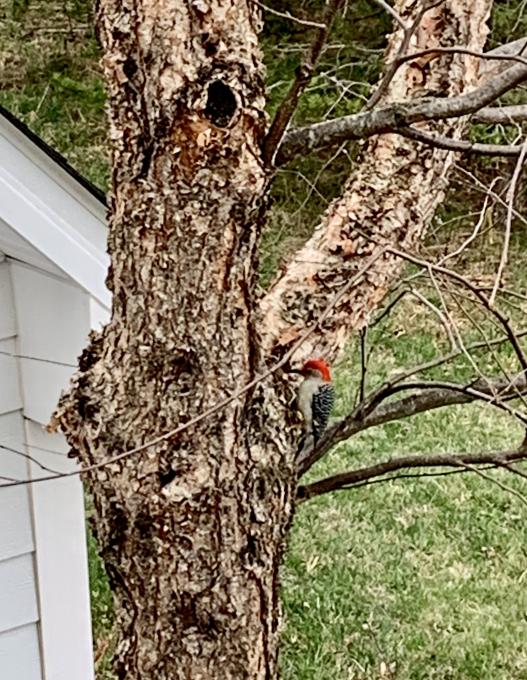Donna
Forum Replies Created
Viewing 6 posts - 1 through 6 (of 6 total)
-
DonnaParticipantActivity 1: The land right around my home has both open field and trees/wooded areas so we have birds that one would expect in that habitat, but do not see water birds. When we ventured to a nature preserve nearby located on the Shenandoah river, we saw great blue herons nesting, plenty of Canada geese, and a bald eagle. When bicycling along the C&O Canal towpath we saw common loons and a green heron on the water in the canal.in reply to: Activities: Exploring Bird Habitats #698339
-
DonnaParticipantActivity 1: I watched a blue jay as he flitted back and forth between the seed feeder, peanut feeder, the ground and a nearby tree. He carried a whole peanut away in his beak and then proceeded to hold it against a branch pecking at it. I also noticed him swiping his beak against the tree branch. Activity 2: The different feeding techniques I noticed were the downy and hairy woodpeckers pecking away at the peanut feeder, a house finch at a seed feeder picking at the seeds, a pair of rose breasted grosbeaks eating black oil sunflower seeds on the feeder and spitting out the hulls, and mourning doves and red wing black birds foraging together eating the seeds on the ground. Activity 3: I heard at least 12 different species based on songs/calls. I find this to be the most difficult aspect of bird identification - associating the call with the bird out in the real world! The ones that I heard today that I can reliably identify are the blue jay, cardinal, red wing blackbird, American crow, mourning dove, gray catbird and pileated woodpecker (who was off in the distance).in reply to: Activities: Noticing Behaviors #696967
-
DonnaParticipantActivity 2: 3 species that are present year round in my area are Northern cardinal, common grackle, and house finch, all of whom we see regularly. 3 species that are present for only part of the year (during breeding only) are the ruby-throated hummingbird (which we see at our feeders), tree swallow (which nests in our boxes), and chimney swift - which I don't recall ever seeing but now that I know to look for it I will! I'm enjoying all of these activities as they are making me much more aware of my surroundings!.in reply to: Activities: Different Seasons, Different Birds #696258
-
DonnaParticipantActivity 1: I watched the feeders and birdhouses in our yard/field. I saw mainly common birds today: Northern cardinal, blue jay, red wing blackbird, common grackle, mourning dove, gray catbird (they love hanging out in our arborvitae trees), robin, downy woodpecker (on the suet as always) and at the houses we have tree swallows, house sparrows and Eastern bluebirds who have all nested and flit in and out. Activity 2: I had not used the Merlin bird app before this course and I really enjoy having that information at my fingertips! Knowing what's most likely to be seen helps me to identify the birds easier. Activity 3: The 5 birds that I didn't know about in my area that I read about were: chimney swift, killdeer, green heron, ovenbird, and Northern flicker (which coincidentally I then saw the next morning at the top of a tree in the field).in reply to: Activities: Local Bird Exploration #696248
-
DonnaParticipantDid all of my activities just by watching the birds in our yard/field and at our feeders. Activity 1: 2 birds I can tell apart by shape are American crow and common grackle (we have plenty of both!). Activity 2: 3 birds with same color (red) on different parts of their bodies are Northern cardinal, house finch, and red wing blackbird Activity 3: Watched the downy woodpecker pecking away at the suet cake on our feeding post. Mourning doves were foraging at the ground feeders and piles of seed on the ground. In the yard was a sparrow (to the best I can narrow it down it was either Savannah or White-throated because it had a yellow patch near the eye but was down in the grass so I couldn't see the chest well) doing something I had never seen before - it was picking away at the dandelion seed heads! Activity 4: Red wing blackbird - medium size, black body with distinct red/yellow stripe on shoulder, feeding on the ground with a distinctive call (the first one I was ever able to recognize clearly and attach it to the bird!).in reply to: Activities: Bird ID Practice #695448
-
DonnaParticipantI have always enjoyed birds but this course is a terrific opportunity to get better at identifying them! I knew we had a lot of birds around our land, as we have feeders and several birdhouses spaced over the field. This course has given me the inspiration to consciously notice and count how many different birds we actually have! Just for fun I went outside with binoculars and was able to identify 15 species (thanks to my "All about Backyard Birds" book that I purchased at a visit to Cornell Lab of Ornithology last year). We are lucky to have bluebirds and tree swallows nesting in the houses this year. I've attached a picture of one of our red bellied woodpecker friends. I'm so happy to finally have the time to learn more about the birds!
 in reply to: Activities: Exploring Birds #694240
in reply to: Activities: Exploring Birds #694240
Viewing 6 posts - 1 through 6 (of 6 total)
